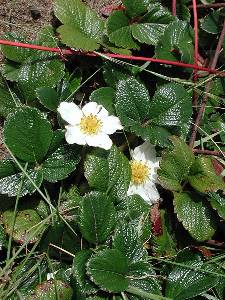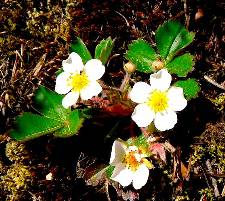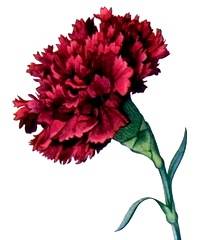On the Origins of New Forms of Life
2.7: Artificial Selection (continued)
(Continued from the previous page)

|
|
Beach Strawberry Fragaria chiloensis Image: Wikimedia |

|
|
Virginia Strawberry Fragaria virginiana Image: Walter Siegmund |
Hybrid Plants and Artificial Selection. Plant breeders, too, commonly start with variable hybrid plants and then apply selection to produce new crops, trees, and flowers with desirable properties. Soliman (1992: 199) claims no other factor has had a greater impact on agricultural production. New breeds produced by hybridization vary widely in the proportion of their genetic composition (Carver and Taliaferro 1992). Some varieties so produced are very close to one parent, but have only one or a few traits from the other (natural processes of this sort are sometimes called "introgression"). At the other end of the spectrum are breeds that derive their traits in equal number from both parents. In the former case, one can think of the new hybrid as a slightly altered version of one of the original parental forms, in the latter as a distinct, new composite.
A complete list of all the new crops derived from the production of hybrid plants followed by selection would be both tedious and beyond the scope of this discussion, but the curious reader is referred to a summary paper on this topic by Kalloo (1992). An inventory of the cultivated flowers derived from hybridization would probably be even more lengthy. Here we will mention only a few examples of the many new breeds of plants derived from hybridization.
For example, a rubber-producing plant from Mexico, guayule (Parthenium argentatum), was crossed with northern relatives to produce hybrid plants that could transfer cold tolerance to guayule (Asker and Jerling 1992: 249). A new variety of okra (Abelmoschus esculentus) resistant to Yellow vein mosaic disease, the most serious disease of that plant, was developed by crossing A. esculentus with A. manihot (edible hibiscus). The modern commercial strawberry is derived from hybridization of the Virginia strawberry (Fragaria virginiana) and the beach strawberry (F. chiloensis). Rockwell et al. (1961: p. 32) say
A great deal of the history of rose breeding, however, is known. Most early European roses did not have the characteristic of continuous, or repeat, bloom as do most roses today (damask roses were an exception). But by the early 1800s, four Chinese rose cultivars, which did bloom repeatedly, had become available to European breeders — a pink and a red China Rose, as well as a blush and a yellow Tea Rose. These were crossed with European roses to produce new repeat-blooming varieties. The first of these new repeat-blooming roses to appear in Europe, the Bourbons, resulted when French breeders crossed China Roses with various Old Roses.
The Hybrid Teas are the most important of the modern roses. They are "the result of hybridising the Hybrid Perpetuals with the Tea Roses in the 1840s. The Hybrid Teas are an entirely new type of rose bearing so little resemblance to those of the past that they might almost be regarded as a new plant. For most of the twentieth century they dominated the rose scene and are still the most popular roses today." Austin notes (2005: 15) that
Early Use of Hybridization. It is certainly true that the "hybridizing process goes back, in most cases, through hundreds of years." A detailed history of this process for all domestic breeds and varieties would fill many volumes. But a few examples will serve to illustrate how long breeders have been using hybridization to produce new plants and animals.
Thus, John Moore (1735) lists various pigeon breeds produced by hybridization. In the first volume of his Histoire Naturelle des Oiseaux (1770), Buffon comments that certain finches (such as the European Goldfinch, Carduelis carduelis, and the Eurasian Siskin, C. spinus) easily cross and that
In addition to such early reports, modern technology has documented examples of breeders' use of hybridization even in ancient times. The Madura breed of cattle, widespread in Indonesia, has been shown by multiple molecular genetic criteria to be derived from hybridization between Zebu and Banteng (B. javanicus). Ward et al. (1999) concluded that these animals were crossed on the island of Madura some 1500 years ago.

|
|
Carnation Dianthus caryophyllus |

|
|
Sweet William Dianthus barbatus Image: Wikimedia |
As for hybrid plants, sometime prior to 1717 Thomas Fairchild (1667-1729) produced a new variety of pink (Dianthus) by crossing a carnation (D. caryophyllus) with a Sweet William (D. barbatus). In that same year Richard Bradley (d. 1732) wrote of obtaining numerous new varieties from hybrid plants in the auriculas of the genus Primula (New Improvements of Planting and Gardening, London, 1717):
The French botanist Henri-Louis DuHamel du Monceau (1728) asserted "almost all the fruits that gardeners call new are only composites of other older ones which can be recognized easily." Zirkle (1935) discusses the work of a variety of eighteenth century plant breeders who produced a wide variety of new vegetables, fruits, and flowers by first producing variable hybrid plants and then applying selection. By end of the eighteenth century Thomas Knight was producing hybrid plants on a large scale to breed a wide array of improved cultivated plants. Linnaeus himself (De sexu plantarum, 1760) enthused about hybrid plants' potential to produce improved crops: